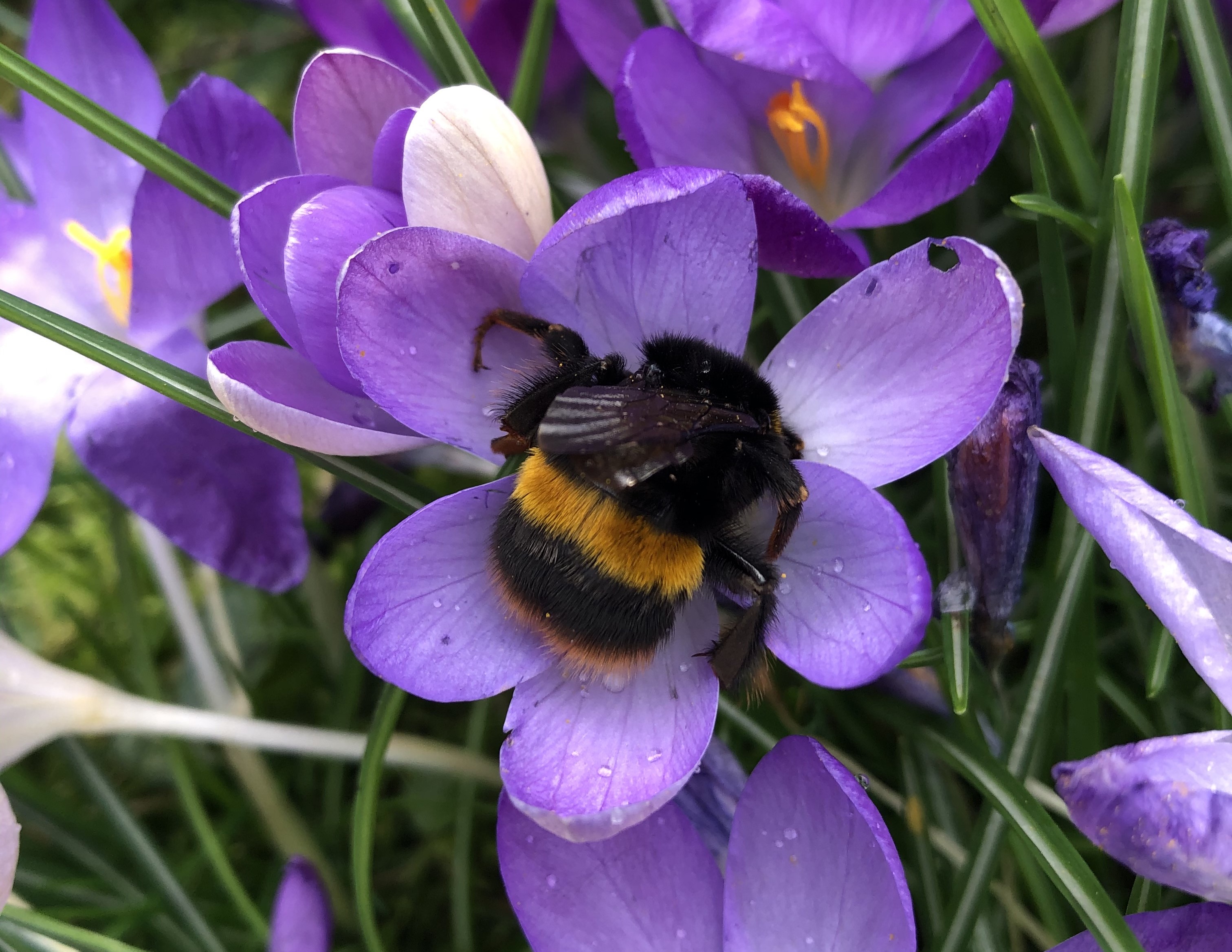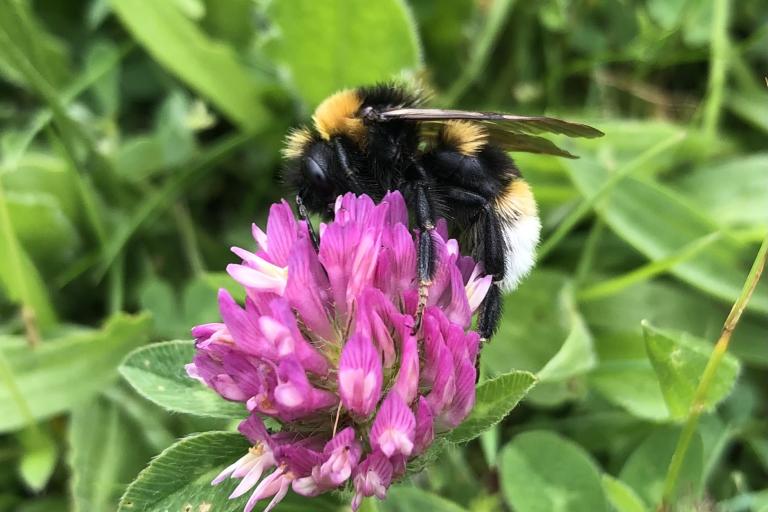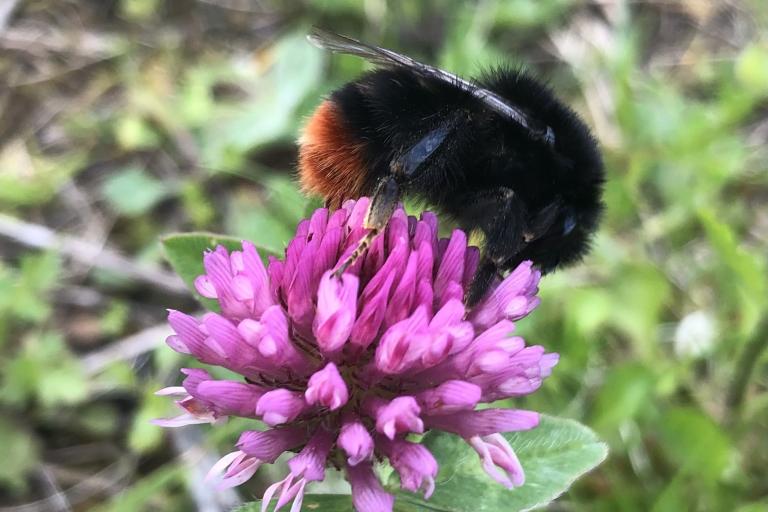Create a buzz with bee-friendly gardens

Bees are among a vast and diverse array of creatures which provide pollination, which in turn allows nature's ecosystems to function. However, recent studies found that a third of bee species have decreased between 1980 and 2019. By supporting wild bees, we will support other pollinators and the insects, birds and mammals that feed on them.
Did you know
The UK is home to 243 species of solitary bee. 24 species of bumble bee and one species of honey bee (according to the Bees, Wasps & Ants Recording Society).
When you’ll see bees
Unlike honey bees, which are domesticated for honey production and do not hibernate, wild bees have a seasonal life cycle linked to that of flowering plants.
They usually hibernate in a safe, undisturbed dry place during the winter, such as abandoned vole holes or the hollow stems of plants such as Cow Parsley and Stonecrops. Huge fluffy buff-tailed bumble bee queens can often be seen (and sometimes heard) foraging as early as January, while most others emerge later in spring and summer when flowers are at their most plentiful. Some wild bee species will continue to forage into late autumn, even into October.
Where they nest
Bees build nests primarily to provide shelter and a space for raising their young, storing food (nectar and pollen), and protecting themselves from predators and harsh weather conditions. Honey bees often have man-made hives, while wild bees have a wide variety of nesting habits. Some solitary bees, for example mining bees or plasterer bees tend to nest in small groups in light soils or sand. Mason bees often nest in crevices in masonry and existing cavities in hollow wood and plant stems.
Leafcutter bees cut out sections of leaves or petals and carry them back to their nest which may be sited in wood, hollow stems or various man-made structures including bee hotels.
Some bumble bees nest underground, others will nest above ground, in holes in trees and bird boxes. Carder bumble bees tend to nest in thick grass, or uncut areas along fence lines.

Vestal cuckoo bumblebee on red clover
Buff-tailed bumblebee on sage

Red-tailed bumblebee on red clover
What can we do to help bees survive
Fill gardens with a wide variety of nectar and pollen rich plants
These plants can provide foraging for bees throughout the year. The Royal Horticultural Society has produced an excellent list of hundreds of plants from honeysuckle in the winter to hydrangeas in the summer. The list includes herbaceous perennials, shrubs and small trees suitable for gardens of all sizes.
Avoid using pesticides
While they are effective, they are often very powerful and kill all insects not just the ones you want gone (less than one per cent of Britain’s insects are garden pests). Instead, you could tolerate some pest damage and use cultivation techniques such as rotation of fruit and vegetables or remove them by hand.
Again, the RHS has produced an excellent information sheet on pesticides for home gardeners. You can purchase plants grown without synthetic pesticides from organic nurseries.
Delay the autumn garden ‘tidy’ until spring
As well as providing a food source (flowering plants), we should also give bees and other wildlife a place to spend the winter, protected from the cold and predators. They may hunker down under a piece of peeling tree bark, or they may stay tucked away in the hollow stem of a fennel plant or an ornamental grass. Some spend the winter as an egg or larvae in a burrow in the ground or as a chrysalis hanging from dead plant stems or tucked into the soil or leaf litter. Queen bumblebees can spend half of their life in hibernation. They need to be able to do this, undisturbed, in your garden.
Not doing the big tidy up until spring could also help ladybirds, one of nature’s most voracious predators of aphids. They like to spend the colder months tucked under a pile of leaves, nestled at the base of a plant, or hidden under a rock. Leaving the garden intact, rather than cutting it back for the winter means you’ll get a jump start on controlling pests in the spring.
Allow lawns to work harder for nature
Longer grass not treated with weed killers or fertilisers increases biodiversity by allowing more plant species to move in, creating a habitat for small creatures and producing flowers to support pollinating insects. Long grass can also make an appropriate place to grow nectar and pollen rich bulbs such as Crocus or Narcissus which may not be suited to beds and borders, while you can also experiment with other early-flowering perennials plants such as Camassia (also known as quamash) in long grass. The RSPB have produced a helpful guide for reducing mower dependency.
Create a pond
According to the UK government website nearly 70 per cent of ponds have been lost from the countryside since the 1800s largely due to drainage and infilling. Garden ponds provide a much-needed habitat for frogs, toads, newts and dragonflies and a water source for insects, birds and mammals. Information about how to create a pond in your garden has been produced by Freshwater Habitats Trust.
Monitor the presence of bees in Oxfordshire
Observe bees for the UK Polinator Monitoring system (POMs) run by Oxfordshire-based UK Centre for Ecology and Hydrology or try the The Bumblebee Book by Nick Owens. Field Studies Council ID chart or The Bumblebee Book by Nick Owens.